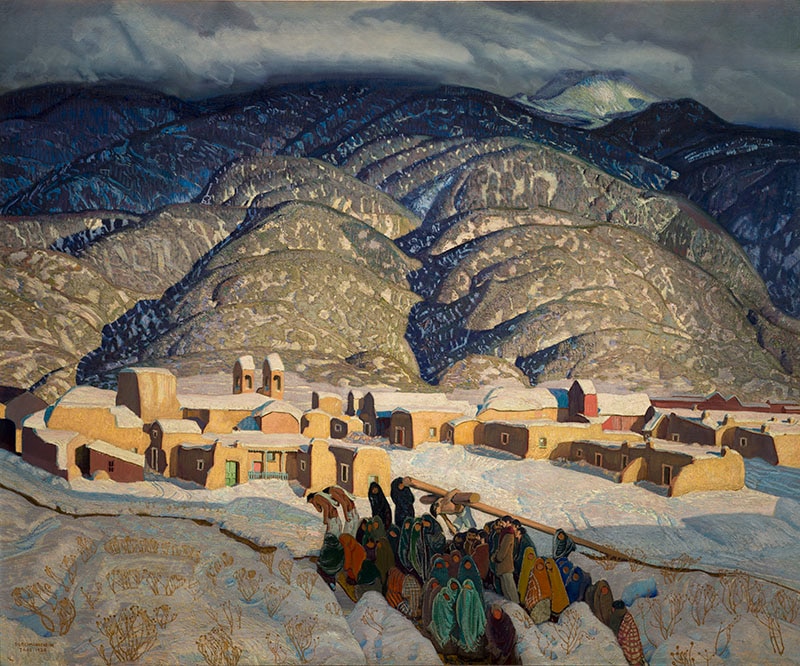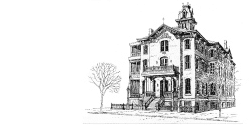Artists in the West
Ernest Blumenschein, Sangre de Cristo Mountains, 1926.
Background Information
As soon as Americans started to explore western North America, artists began to move with them. Many were soon taken with the landscapes and the Native American and Hispanic people that lived in the region. Around centuries-old villages, many artists began to form colonies, like the Taos Society of Artists in New Mexico. These artists found the lifestyle of the people in the village of Ranchos de Taos and the ancient Pueblo of Taos to be romantic, given the rapid modernization elsewhere in the United States, and found a dramatic environment unlike any other they had experienced. The history, people, and places of the Western United States offered artists subject matter that was different from any other, and from the beginning they took advantage of all it had to offer their style and content.
Look Closer

Foreground.
Middleground.
Background.
If you divide the painting into sections based on subject matter, you find the foothills and the mountains behind them make up approximately 50% of the composition.
The village makes up about 25%.
As does the foreground genre scene of villagers.
Think about the style of the painting, and take a look at the way the artist used paint, brush strokes, and color.
Ernest Blumenschein, Sangre de Cristo Mountains, 1926.
Notice the composition in this painting. Pay attention to the foreground1, middle ground2, and background3. If you divide the painting into sections based on subject matter, you find the foothills and the mountains behind them make up approximately 50% of the composition4, the village makes up about 25%5, as does the foreground genre scene of villagers6. Think about the style of the painting, and take a look at the way the artist used paint, brush strokes, and color7.
Discussion Questions
- The artists of the Taos society were hugely influenced by the landscape, as well as the people around them. Describe how the artist has depicted this scene differently or similar to other Western artworks you have seen.
Activity
The first of the artists to reach Taos, New Mexico were Joseph Henry Sharp, Bert Geer Phillips, and Ernest Blumenschein, who encouraged their fellow artist friends to join them. They felt strongly that the environment was conducive to painting, especially because of the bright sunlight, interesting lifestyles of the Native and Hispanic peoples, and unique local architecture and landscape. Eventually, several of the artists moved to Taos permanently or relocated for parts of the year.
Imagine you are a permanent member of the Taos Society of Artists. Your artist-friend from back East has recently come to visit, and really enjoyed their time in Taos, but wasn’t sure if they wanted to make it their permanent home. Write your friend a postcard describing why it is the ideal location for an artist to live and work. On the other side of the postcard, make a picture of your favorite scene to show off the place. To make a strong case, you may choose to use images from this website, research New Mexico, or find historical and contemporary photographs or writings from and about this region.
Materials:
Postcard worksheet
Colored pencils/crayons/markers/watercolors
Pencil/pen
Optional materials:
Ernest Blumenschein’s painting, Sangre de Cristo Mountains
Images of New Mexico, then and now
Grade levels: P-12 CO Standards
Visual Arts (2020)
Preschool: 1.1-2 ; 2.1 ; 3.1 ; 4.1
Kindergarten: 1.1-2 ; 2.1 ; 3.1 ; 4.1
1st Grade: 1.1 ; 2.1 ; 3.1 ; 4.1
2nd Grade: 1.1 ; 2.1 ; 3.1 ; 4.1
3rd Grade 1.1 ; 2.1-2 ; 3.1 ; 4.1-2
4th Grade: 1.1-2 ; 2.1-2 ; 3.1-2 ; 4.1
5th Grade: 1.1-2 ; 2.1-2 ; 3.1-2 ; 4.1
6th Grade: 1.1-3 ; 2.1-2 ; 3.1-3 ; 4.1-3
7th Grade: 1.1-3 ; 2.1-2 ; 3.1-2 ; 4.1-2
8th Grade: 1.1-3 ; 2.1-2 ; 3.1-3 ; 4.1-3
High School 1.1-3 ; 2.1-3 ; 3.1-3 ; 4.1-3
Social Studies (2020)
Preschool: 1.1 ; 2.1 ; 3.1 ; 4.1
Kindergarten: 1.1-2 ; 2.2
1st Grade: 1.1-2 ; 2.1-2 ; 3.1 ; 4.1
2nd Grade: 1.1-2 ; 2.1-2
3rd Grade: 1.1-2 ; 2.1-2; 3.1 ; 4.1
4th Grade: 1.1-2 ; 2.2 ; 3.1
5th Grade: 2.1-2
6th Grade: 1.1-2 ; 2.1-2 ; 4.1
7th Grade: 1.1
8th Grade: 2.1-2
High School: 1.1-3 ; 2.1-3
Reading, Writing and Communicating (2020)
Preschool: 1.1-2 ; 2.1 ; 3.1 ; 4.1
Kindergarten: 1.1-2 ; 2.3 ; 3.1-4 ; 4.1
1st Grade: 1.1-2 ; 2.2-3 ; 3.1-4 ; 4.1
2nd Grade: 1.1-2 ; 2.2-3 ; 3.1-4 ; 4.1
3rd Grade: 1.1-2 ; 2.1-3 ; 3.1-4 ; 4.1
4th Grade: 1.2 ; 2.1-3; 3.1-4 ; 4.1
5th Grade: 1.1-2 ; 2.1-3 ; 3.1-4 ; 4.1
6th Grade: 1.1-2 ; 2.1-3 ; 3.1-4 ; 4.1
7th Grade: 1.2 ; 2.2-3 ; 3.2-4 ; 4.1
8th Grade: 1.1-2 ; 2.2-3 ; 3.2-4 ; 4.1
9th/10th Grade: 1.1-2 ; 2.3 ; 3.2-4 ; 4.1
11th/12th Grade: 1.1-2 ; 2.2-3 ; 3.2-4 ; 4.1
Resources



